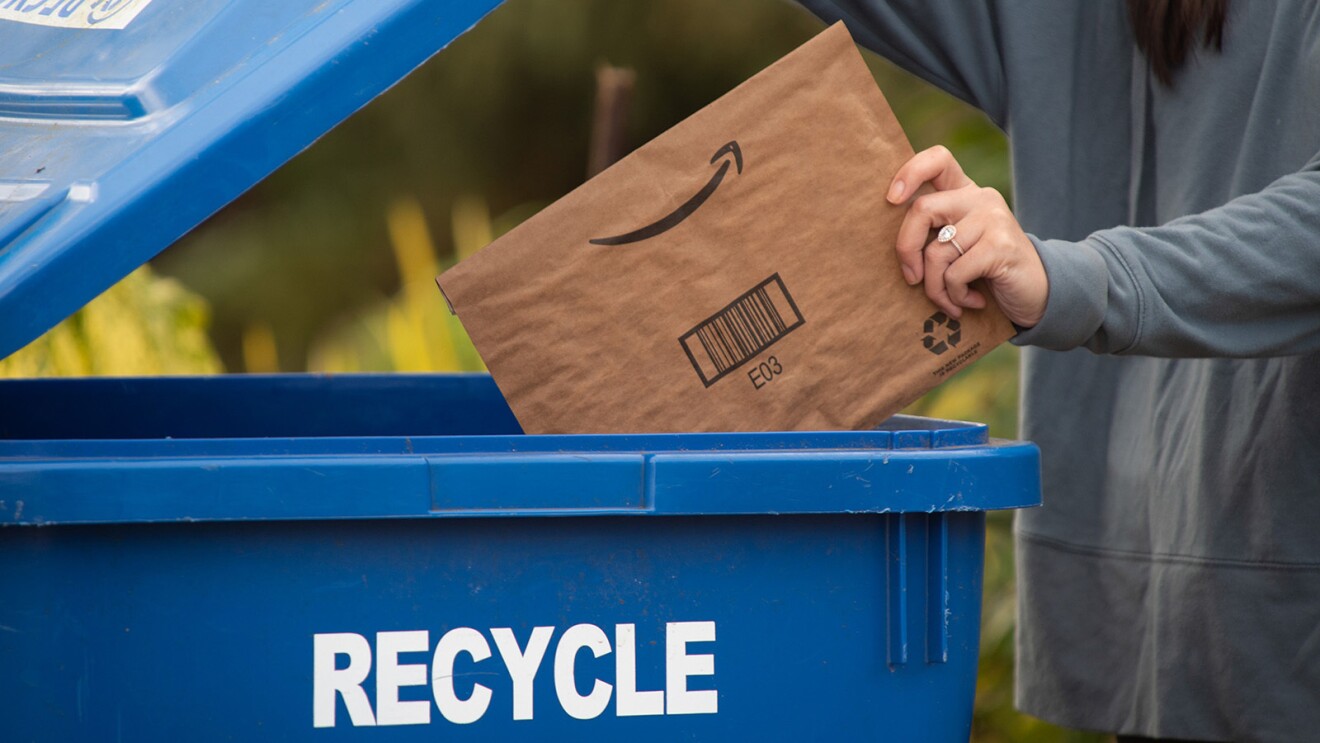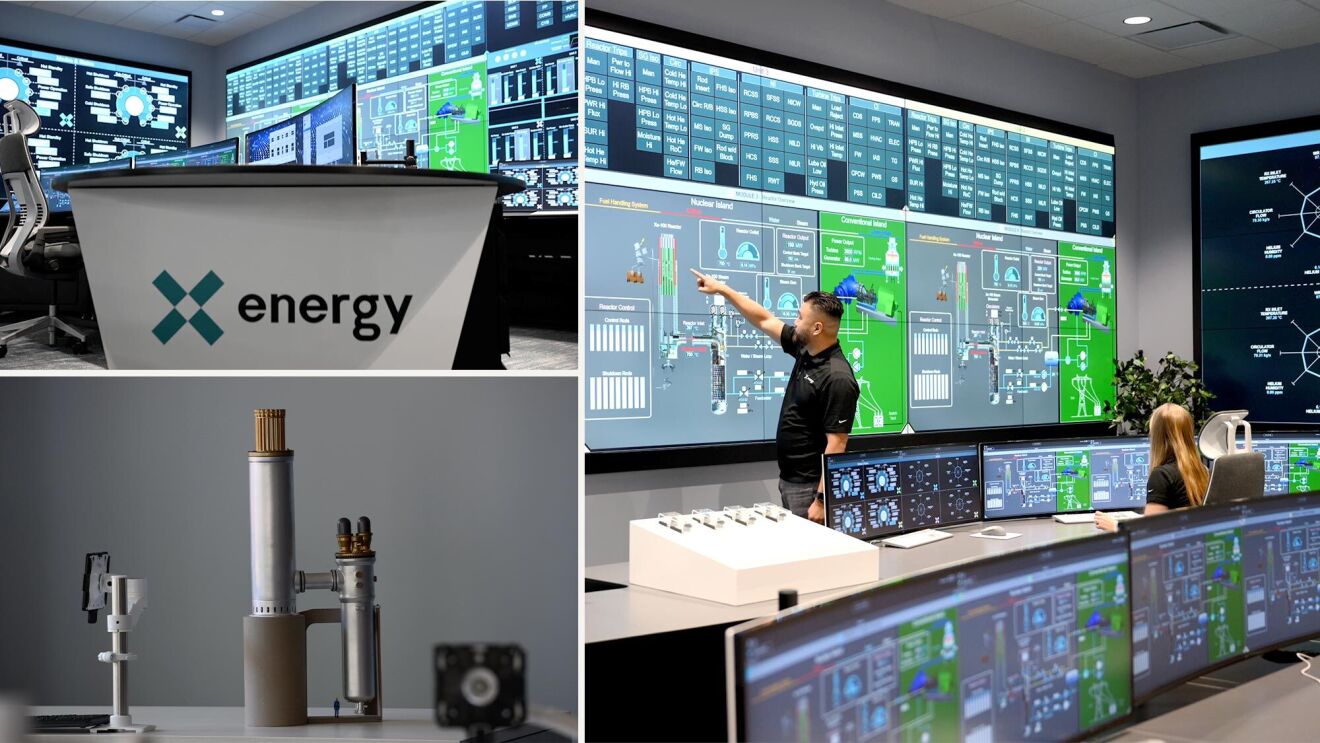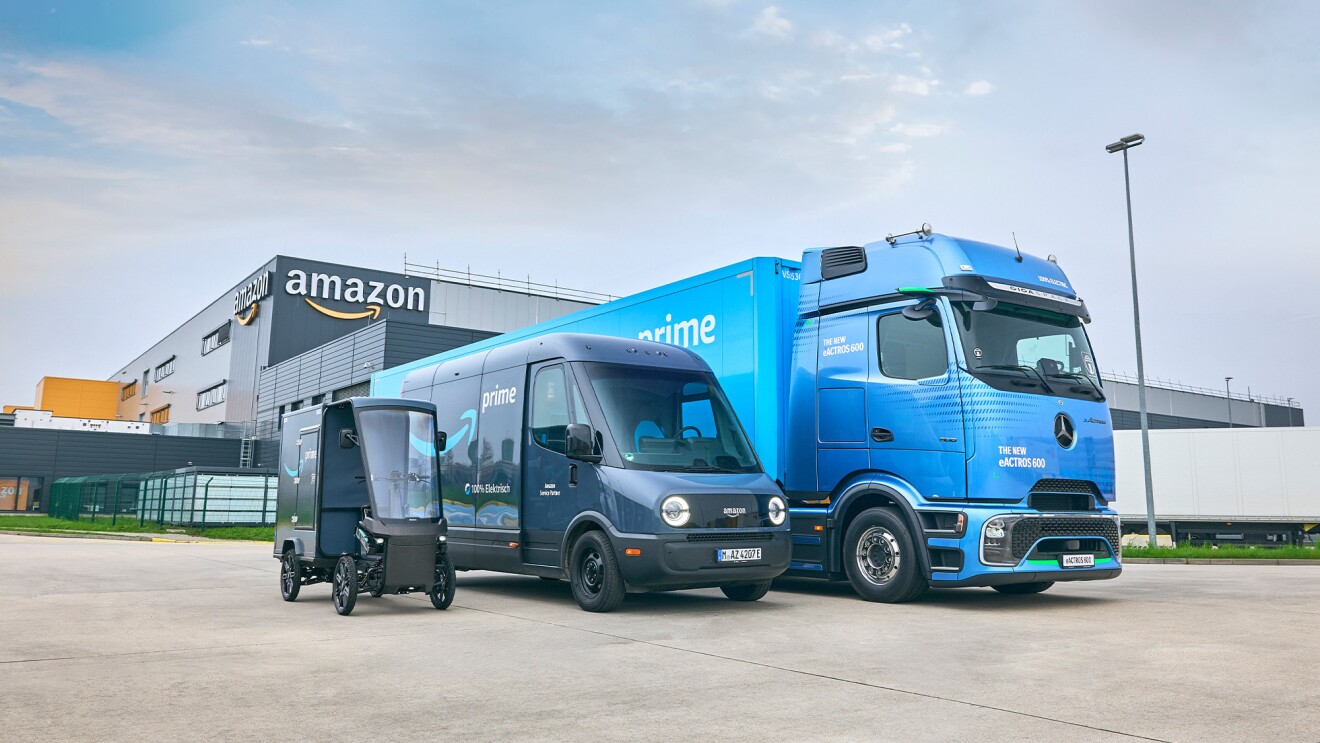Amazon's second headquarters in Arlington, Virginia, was built with sustainability at its core. The campus is designed to demonstrate what's possible when it comes to sustainable construction and design, and benefit the local community.
The soon-to-open campus at Metropolitan (Met) Park was built using new, climate-friendly solutions at scale—including low-carbon concrete, mass timber, electrified energy-efficient operations, advanced ways to reuse water, and two acres of landscaped roofs with native plants.
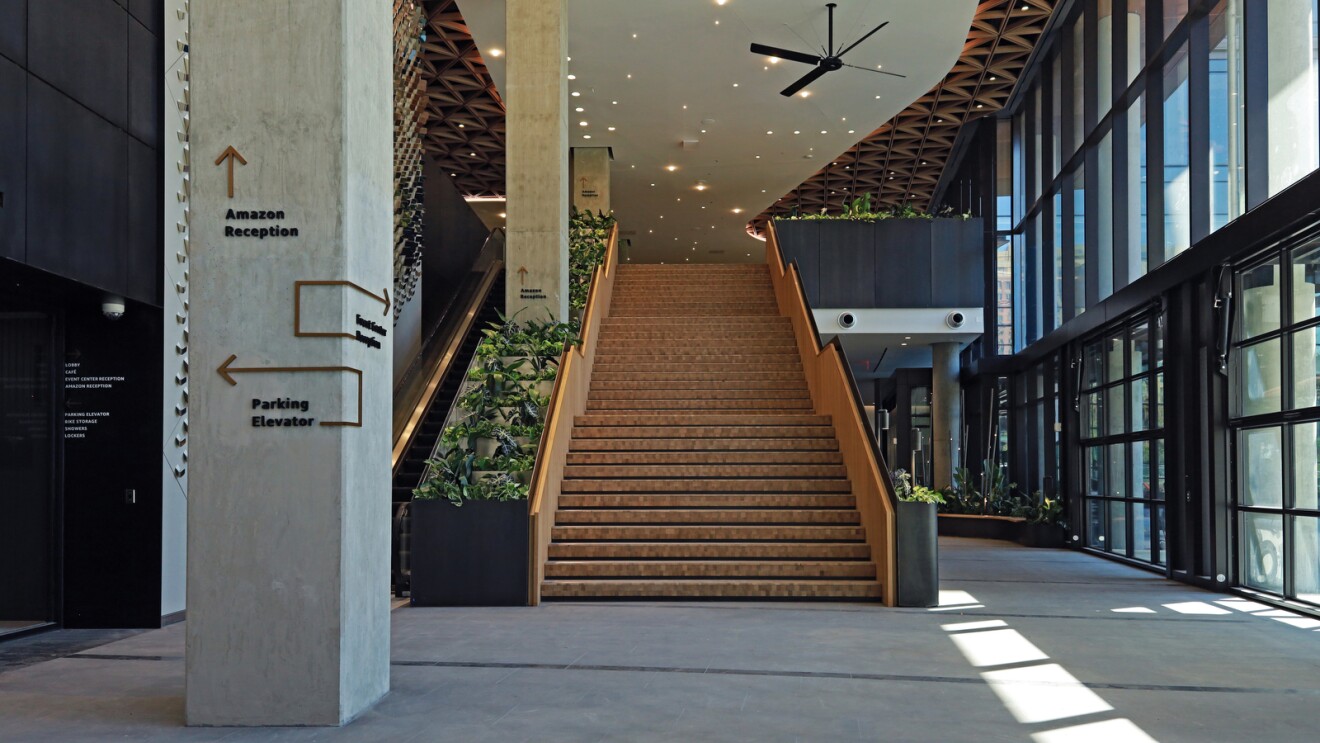 Energy-efficient “Eco-Lobbies” at Metropolitan Park blur the transition from indoor to outdoor. Large operable walls open into the park on nice days, and lush landscaping and natural materials throughout to help bring the outside in. Passive design strategies, such as overhead high-volume, low-speed fans and hydronic radiant floor heating, create a thermally comfortable environment for occupants.
Energy-efficient “Eco-Lobbies” at Metropolitan Park blur the transition from indoor to outdoor. Large operable walls open into the park on nice days, and lush landscaping and natural materials throughout to help bring the outside in. Passive design strategies, such as overhead high-volume, low-speed fans and hydronic radiant floor heating, create a thermally comfortable environment for occupants.The buildings will run with zero operational carbon emissions, meaning we do not rely on any fossil fuels for the building’s daily operation. Here are some highlights about the campus:
- 100% powered by renewable energy.
- 24% overall energy savings relative to a comparable new office building—enough electricity to power 572 homes in the U.S. every year.
- 20% reduction in the carbon footprint of Met Park’s concrete structures compared to the industry baseline—saving over 14,700 metric tons of carbon, or the equivalent of taking more than 3,200 cars off the road in the U.S. for an entire year.
- Certified as Targeting Leadership in Energy and Environmental Design (LEED) Platinum—the highest level of LEED certification. Met Park is on track to be the largest LEED v4 Platinum building in the U.S.
“Constructing buildings that can house thousands of employees on a daily basis, while operating more efficiently—and not disrupting, but rather enhancing the natural environment—is no small feat. I’m proud of the work our teams have done with HQ2 to make that a reality,” said Kara Hurst, vice president for Worldwide Sustainability at Amazon.
“While it’s not always necessarily visible to our customers or communities, we’re working to decarbonize all of Amazon’s buildings—including our corporate offices, data centers, and fulfillment facilities—given the climate impact of the built environment." Hurst said. "At HQ2, we challenged ourselves to push the limits of what’s possible when it comes to sustainable construction and design—and we’re proud to share these features with the northern Virginia community.”
Buildings account for nearly 40% of annual global CO2 emissions. Buildings consume more energy than both the industrial and transportation sectors, and large-scale developments are particularly challenging. This is because many low-carbon solutions are impractical to implement or unproven at scale, can’t be delivered due to current regulations, or require significant investment in infrastructure for limited benefit.
We took on these challenges to find ways to decarbonize Amazon’s real estate portfolio in order to meet our Climate Pledge commitment. We also know that if we can do this, we can help drive change across industries and propel us all forward in efforts to reduce carbon emissions. Met Park exemplifies carbon-reduction solutions and energy-efficiency enhancements that are possible today.
Read on for a look at the carbon reduction and energy enhancements at Met Park:
Low-carbon building construction
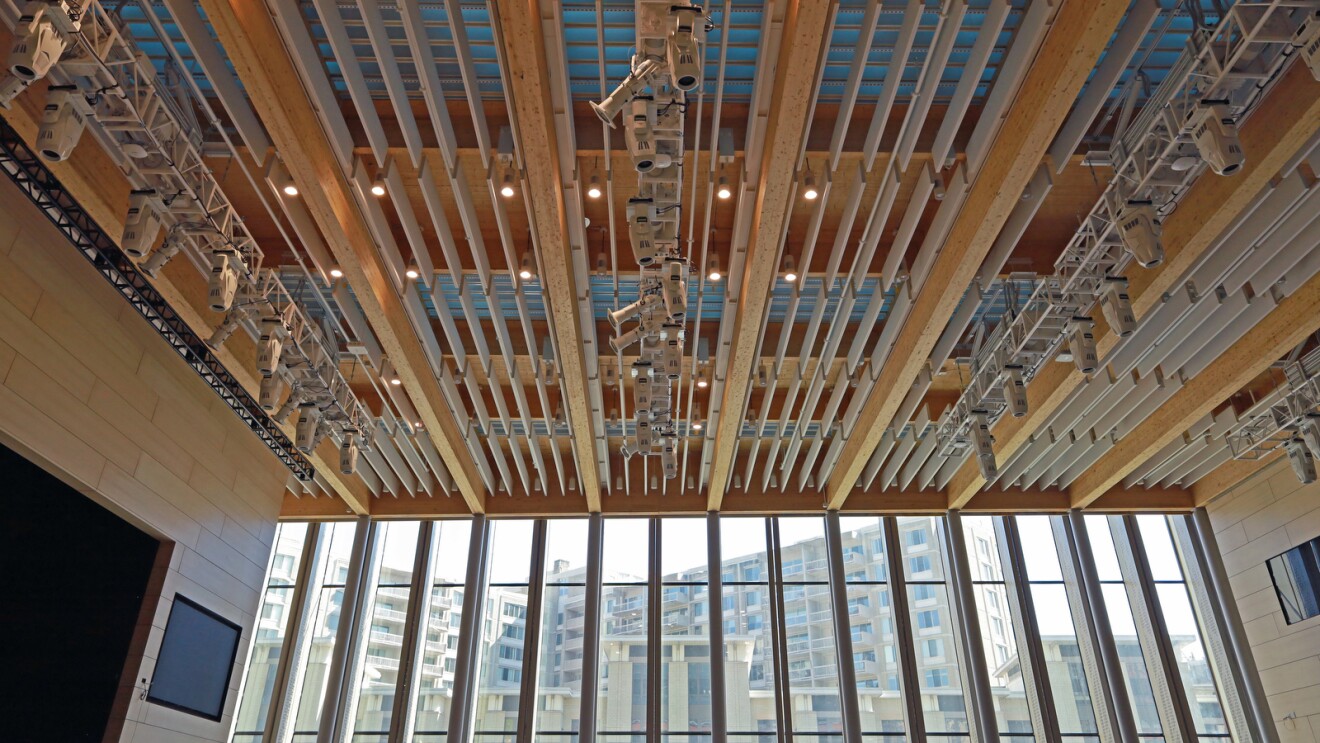 Ten 70-foot-long glue laminated timber beams support the Met Park meeting center ceiling, lowering the embodied carbon of the building and creating a warm, tactile, biophilic environment for occupants.
Ten 70-foot-long glue laminated timber beams support the Met Park meeting center ceiling, lowering the embodied carbon of the building and creating a warm, tactile, biophilic environment for occupants.We started with reducing the carbon footprint of all of the concrete used in the buildings. Concrete alone accounts for over 7% of all greenhouse gas emissions worldwide. Using advanced low-carbon concrete mix design and CarbonCure, which we invested in through our Climate Pledge Fund, we were able to achieve a 20% reduction in the carbon footprint of Met Park’s concrete structures compared to the industry baseline.
This technology introduces recycled carbon dioxide into fresh concrete to reduce its carbon footprint without compromising performance. Concrete makes up the largest portion of the project’s total embodied carbon footprint, making low-carbon concrete one of the most impactful ways to reduce emissions associated with the building itself. This same CarbonCure technology is now being utilized at over 40 Amazon sites globally.
The Met Park meeting center ceiling is also constructed with cross-laminated timber and supported by 10 70-foot-long glue laminated timber beams. Wood absorbs carbon as it grows and continues to store that carbon throughout its material lifecycle in the building. By using structural timber, we have an opportunity to expand industry knowledge of the material in the region, paving the way for its broader adoption in the future.
Electrified operations
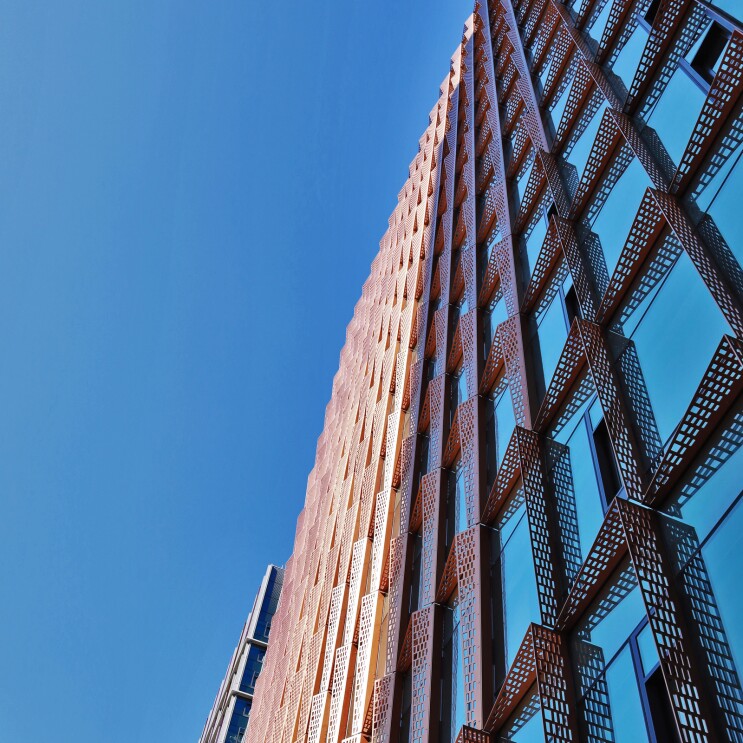 Sunshades on the exterior of Met Park reduce direct sunlight into the building, saving cooling energy and decreasing glare.
Sunshades on the exterior of Met Park reduce direct sunlight into the building, saving cooling energy and decreasing glare.Within the buildings, the HVAC systems that heat and cool the space, the water heaters that serve the sinks and showers, and even the food service equipment used in our kitchens are powered fully from electricity. This means that we’ve eliminated the use of fossil fuels within the buildings for daily operations. Met Park will be powered with 100% renewable energy procured from a solar farm in Virginia.
New ways to recycle water
Met Park is designed to conserve natural resources and be resilient to future climate impacts such as increased temperatures and droughts in the region. We are using technology to reclaim and recycle water for elements like cooling towers, landscape irrigation and flushing fixtures. Low-flow urinals, toilets, and lavatories throughout HQ2 exceed U.S. Environmental Protection Agency (EPA) requirements by nearly one-third, which will help conserve water and energy even as our community grows.
By capturing and reusing rainwater, shower water, and HVAC condensate, the building is expected to achieve 50% water savings below building code, and recycle 7.5 million gallons per year—more water than it takes to fill the Lincoln Memorial reflecting pool.
Incorporated green roofs and native plants
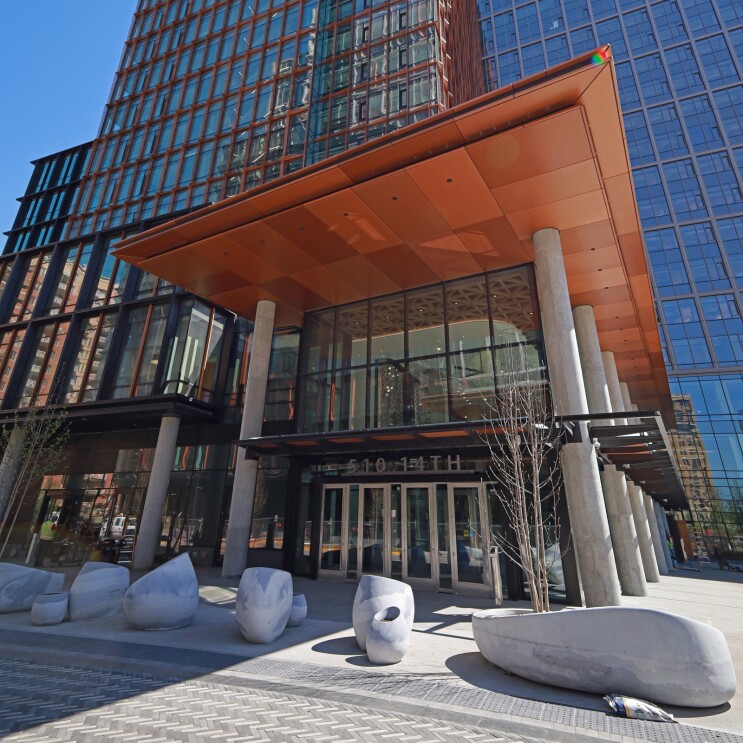 Located along a major bird migratory corridor, Met Park is designed to consider impacts to the local wildlife. The lower levels of glass include a dot frit pattern to improve visibility to birds, alerting birds of a solid barrier and reducing the risk that they attempt to fly through.
Located along a major bird migratory corridor, Met Park is designed to consider impacts to the local wildlife. The lower levels of glass include a dot frit pattern to improve visibility to birds, alerting birds of a solid barrier and reducing the risk that they attempt to fly through.Met Park has two acres (or 90,000 square feet) of landscaped green roofs with native plantings where visitors and employees alike can find reprieve and connect to nature. Eight of the buildings’ 19 landscaped terraces provide amenities ranging from outdoor meeting spaces and dog runs to an urban farm. On one of our terraces, the Amazon Horticulture team is leading a program that partners with a local organization, Love and Carrots, to grow produce and deliver the produce to a local nonprofit, Kitchen of Purpose.
These green roofs help reduce energy consumption by swapping synthetic, impervious materials with plant life. Conventional roofs and pavement absorb sunlight, convert that energy into heat, and warm the surrounding structures—putting greater strain on the HVAC system. Green roofs and landscaping mitigate this effect through the naturally cooling functions of plants, reflecting solar energy and off-setting heat through evaporation.
Our landscaping was planned with native and adaptive plantings that are conducive to the climate of Arlington. They include a wide variety of plants selected to attract local pollinator species. Additionally, the soil is engineered to retain water and promote root growth while smart and low-flow irrigation systems are optimized to reduce water consumption by providing only what the native plants need.
 The Level 19 rooftop terrace, landscaped with native and adaptive plantings, is one of the 19 green roofs at Met Park. This outdoor gathering space, with trellises to provide protection from direct sunlight, provides reprieve for building occupants.
The Level 19 rooftop terrace, landscaped with native and adaptive plantings, is one of the 19 green roofs at Met Park. This outdoor gathering space, with trellises to provide protection from direct sunlight, provides reprieve for building occupants.Helping small businesses eliminate fossil fuels
We’ve also worked with the owners of small businesses that will occupy the 50,000 square feet of retail space at Met Park on reducing the carbon impact of their own operations.
As part of our leasing process, we worked together with tenants to explore electrification and help them understand how to move away from fossil fuel consumption while maintaining their amazing food and experience. We’re proud that 100% of our retail spaces will be all-electric, including restaurants and other food services.
Keeping construction materials out of landfills
Construction waste is a significant portion of the waste produced in the world. The Virginia Department of Environmental Quality reports that in 2021, 4.3 million tons of construction and demolition waste was generated, 65% of which was sent to landfills. Keeping these materials out of landfills prevents ground and water pollution, promotes recycling, and keeps materials in active use longer.
For the construction of Met Park, 82% of all construction waste materials were diverted from landfills, including concrete, drywall, metals, wood, cardboard, and plastic. This process kept over 17,000 tons of material—more than four times the weight of the U.S. Capitol Dome—from entering landfills.
Learn more about how we’re making buildings more sustainable across our operations, including data centers, physical stores, and fulfillment facilities around the world.




